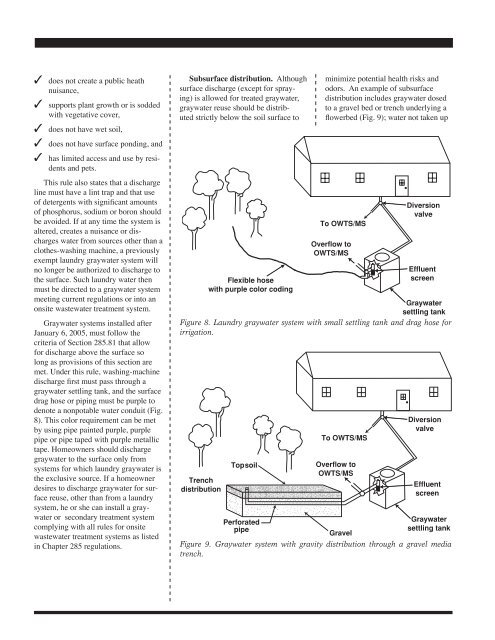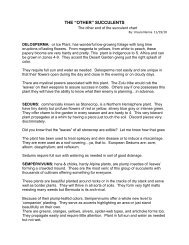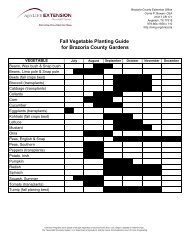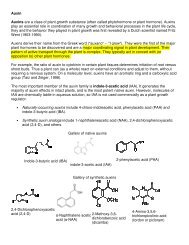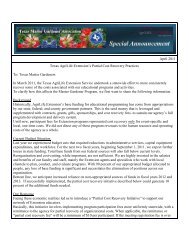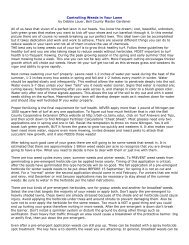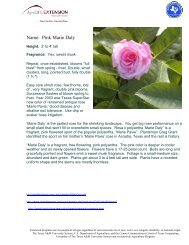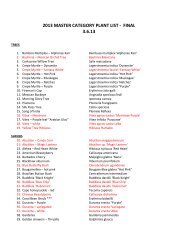Graywater - Texas Master Gardeners Association
Graywater - Texas Master Gardeners Association
Graywater - Texas Master Gardeners Association
Create successful ePaper yourself
Turn your PDF publications into a flip-book with our unique Google optimized e-Paper software.
does not create a public heath<br />
nuisance,<br />
supports plant growth or is sodded<br />
with vegetative cover,<br />
does not have wet soil,<br />
does not have surface ponding, and<br />
has limited access and use by residents<br />
and pets.<br />
This rule also states that a discharge<br />
line must have a lint trap and that use<br />
of detergents with significant amounts<br />
of phosphorus, sodium or boron should<br />
be avoided. If at any time the system is<br />
altered, creates a nuisance or discharges<br />
water from sources other than a<br />
clothes-washing machine, a previously<br />
exempt laundry graywater system will<br />
no longer be authorized to discharge to<br />
the surface. Such laundry water then<br />
must be directed to a graywater system<br />
meeting current regulations or into an<br />
onsite wastewater treatment system.<br />
<strong>Graywater</strong> systems installed after<br />
January 6, 2005, must follow the<br />
criteria of Section 285.81 that allow<br />
for discharge above the surface so<br />
long as provisions of this section are<br />
met. Under this rule, washing-machine<br />
discharge first must pass through a<br />
graywater settling tank, and the surface<br />
drag hose or piping must be purple to<br />
denote a nonpotable water conduit (Fig.<br />
8). This color requirement can be met<br />
by using pipe painted purple, purple<br />
pipe or pipe taped with purple metallic<br />
tape. Homeowners should discharge<br />
graywater to the surface only from<br />
systems for which laundry graywater is<br />
the exclusive source. If a homeowner<br />
desires to discharge graywater for surface<br />
reuse, other than from a laundry<br />
system, he or she can install a graywater<br />
or secondary treatment system<br />
complying with all rules for onsite<br />
wastewater treatment systems as listed<br />
in Chapter 285 regulations.<br />
Subsurface distribution. Although<br />
surface discharge (except for spraying)<br />
is allowed for treated graywater,<br />
graywater reuse should be distributed<br />
strictly below the soil surface to<br />
o o o o o o o o o o o o o o o o o o o o o o o o o o o o o o o o o o o o o o o o o o o o o o o o o o o o o o o o o o o o o<br />
minimize potential health risks and<br />
odors. An example of subsurface<br />
distribution includes graywater dosed<br />
to a gravel bed or trench underlying a<br />
flowerbed (Fig. 9); water not taken up<br />
Figure 8. Laundry graywater system with small settling tank and drag hose for<br />
irrigation.<br />
Figure 9. <strong>Graywater</strong> system with gravity distribution through a gravel media<br />
trench.


